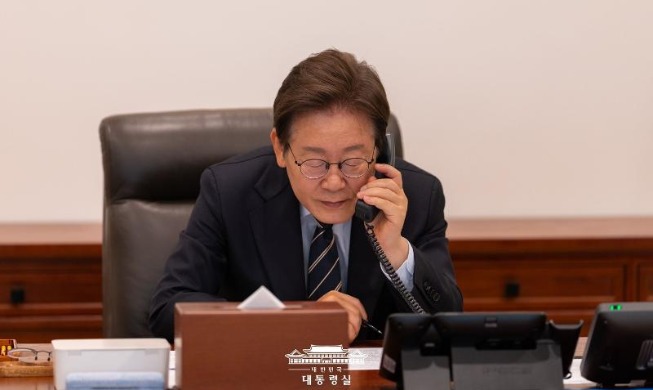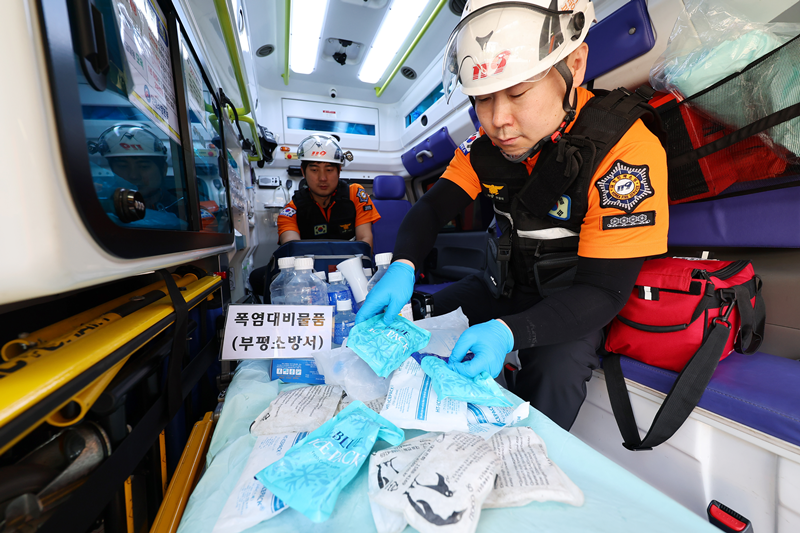
Paramedics on the morning of June 18 inspect cooling items such as ice packs in an ambulance at the Bupyeong Fire Station in Incheon's Bupyeong-gu District. (Yonhap News)
By Hong Angie
"This summer is so hot that it feels like being trapped in a wet sauna."
This is how Seoul residents felt last month as the average daily temperature high exceeded 30 degrees Celsius for the first time in recorded history.
The Korea Meteorological Administration has forecast a hotter-than-normal summer due to the high potential for warm southerly wind currents and heavy rain from stronger inflow of moist vapor stemming from the westward expansion of subtropical high pressure in the Northwest Pacific.
With the year's first heat warning first issued in Seoul and followed by those in the Yeongnam region spanning Busan, Daegu, Ulsan and the two Gyeongsang-do provinces, more people have been rushed to hospitals on ambulances due to heat-related ailments like heat stroke.
The central and local governments accordingly face the challenge of responding to the national heat wave. With scorching temperatures in summer posing a safety threat for the country, more places are taking a welfare approach toward the problem.
The Korea Disease Control and Prevention Agency (KDCA) is running an emergency room (ER) surveillance system for heat-related ailments connecting about 500 medical institutions with ERs nationwide and public health centers or KDCA branches in the provinces. The system identifies patients suffering from heat-related illnesses who visit ERs and monitors the effects of the heat wave on health.
The collected data is released to the public daily on the KDCA website.
Guidelines also seek to prevent heat-related illness and related damage including drinking water frequently, staying cool under shade and refraining from outdoor activities during peak heat hours.
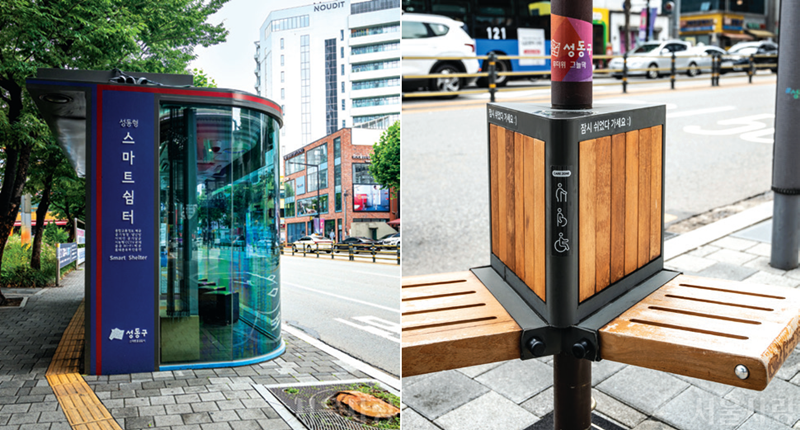
On the left is a smart heat shelter at a bus station and on the right are public chairs under a shade, both in Seoul. (Seoul Metropolitan Government)
Local governments have also launched measures for summer such as expanding or extending heat shelters and preparing for torrential rains.
The Seoul Metropolitan Government from this year has designated select convenience stores as "climate companion rest areas," where anyone can visit and rest 24 hours a day. Welfare and geriatric community centers, government offices and libraries are also taking on the role of a summer heat shelter that runs from 9 a.m. to 6 p.m. daily.
These places will run longer until 9 p.m. on days when a heat advisory is issued. Accommodations in a region also provide late-night shelter from 9 p.m. until 7 a.m. the next day.
Shades and fans are installed at public construction sites following heat warnings. Water sprayed on streets lower city temperatures and energy vouchers for low-income residents reduce their electricity bills.
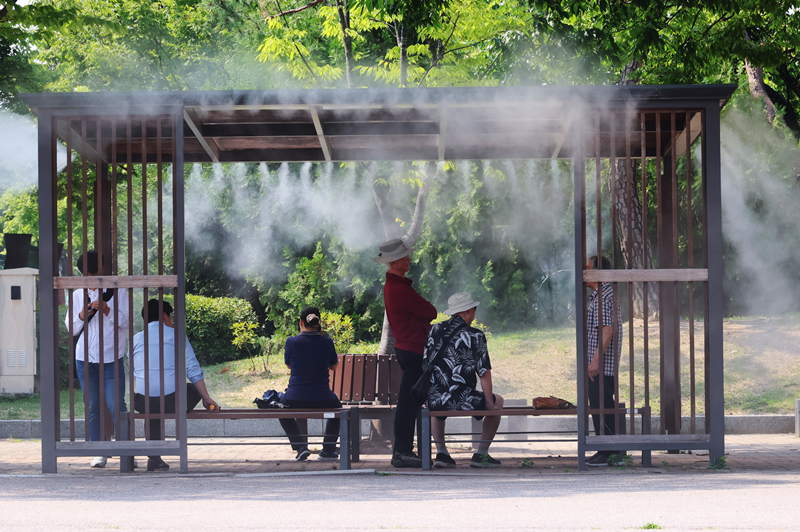
People in June stand under a sprinkler spraying cooling fog at Yeouido Park in Seoul's Yeongdeungpo-gu District. (Yonhap News)
Incheon City Hall has set up 1,347 summer heat shelters at senior citizen and welfare centers. It also has deals with 12 lodging facilities to provide safe accommodations for those vulnerable to heat including elderly people who live alone.
The 17 cities and counties of Gyeonggi-do Province -- Gwangju, Suwon, Hanam, Seongnam, Siheung, Gwangmyeong, Bucheon, Goyang, Anyang, Uiwang, Pocheon, Paju, Yongin, Icheon, Guri, Ansan and Namyangju -- run 21 heat shelters for migrant workers and plan to open more at 61 affiliates and public agencies.
A cooperative system also allows heat-sensitive residents to use 31 public shelters in Gyeonggi-do's cities and counties.
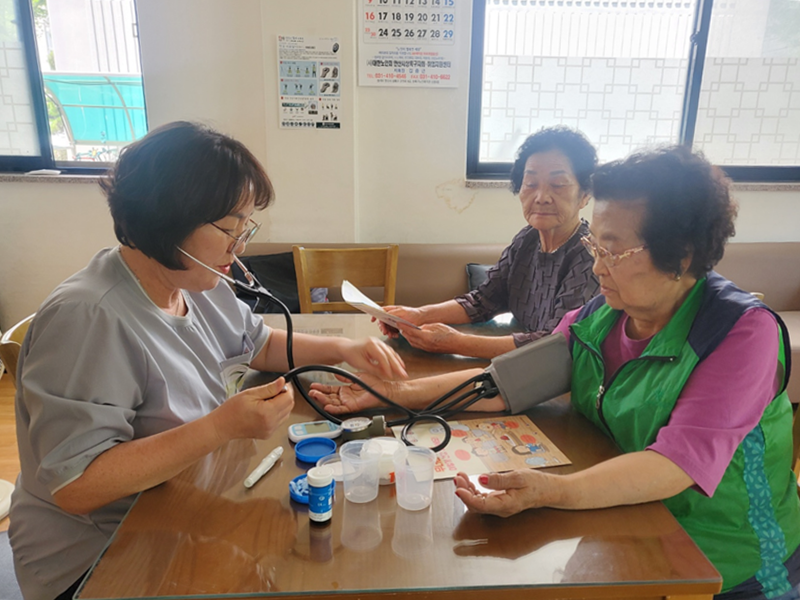
The city of Ansan, Gyeonggi-do Province, runs a support group for preparation for a heat wave with professionals like visiting nurses to help the underprivileged such as senior citizens who live alone or welfare recipients. Shown are two elderly women receiving treatment for heat-related ailments. (Ansan City Hall)
Given the expected prolonged heat wave this summer, Ansan City Office has launched a response to manage the health of the underprivileged such as senior citizens who live alone.
Two of the city's public health centers, Sangnoksu and Danwon, have such teams to help the socially disadvantaged like senior citizens who live alone and basic welfare recipients have a healthy summer. Visiting nursing services for people aged 65 or older will be expanded.
Intensive health management services include training in rules to beat the heat, items to protect against high temperatures like cooling overshoes, continuous health monitoring through checkup calls and text messages.
Each local government has a team for responding to the heat wave, devising measures to ensure a safe and enjoyable summer for the public.
shong9412@korea.kr
